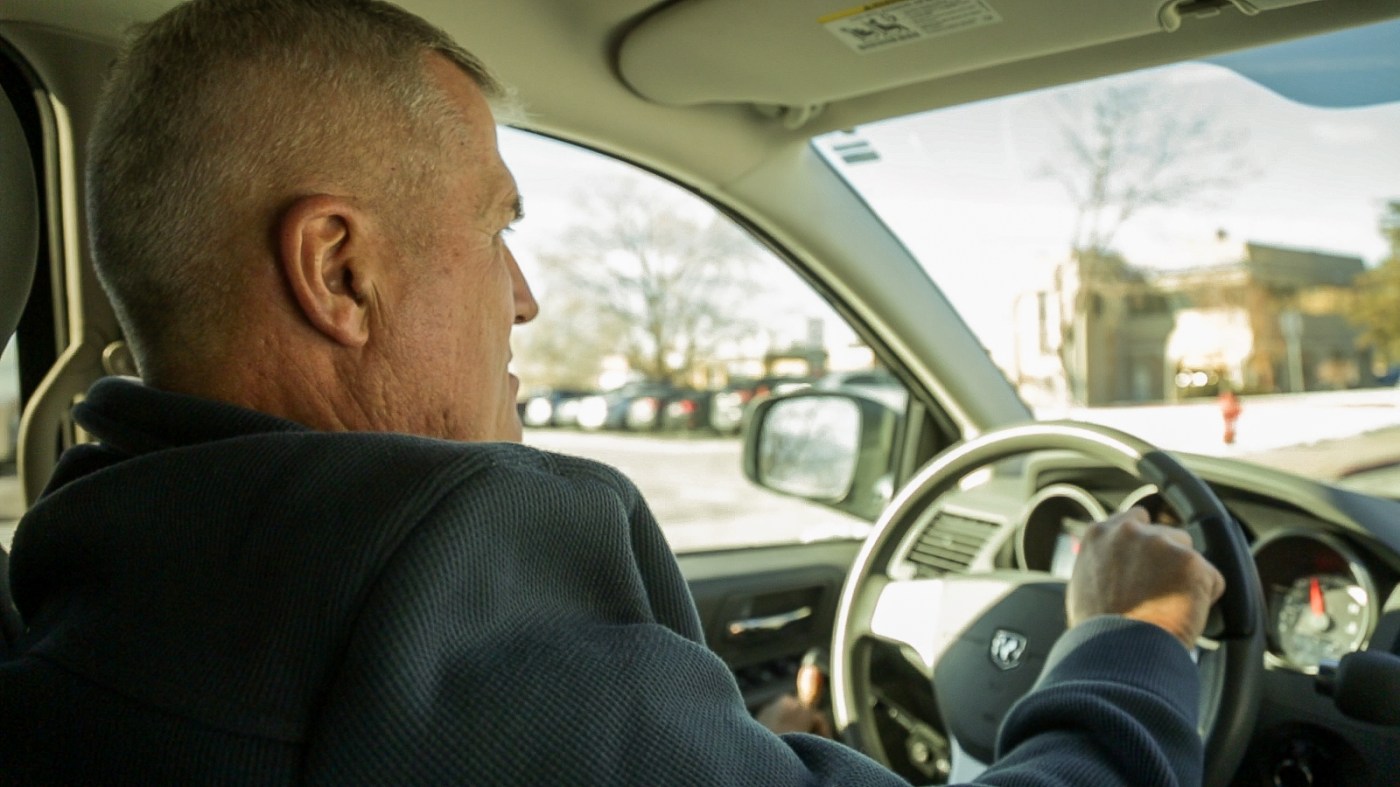
Occupational Therapists Robyn Little (left) and Bonnie Fernelius are the driving forces behind VA Salt Lake City’s driver rehab program.
Freedom, independence, and confidence—just a few things Veterans say the driver rehab program at VA Salt Lake City Health Care System provided them.
Driver Rehabilitation Specialists and Occupational Therapists, Robyn Little and Bonnie Fernelius, work with Veterans to evaluate their driving skills and instruct them to safely and confidently use a motor vehicle with or without adaptive equipment. They see their program as opening doors that a lot of Veterans have closed or do not know exist.
Change in Ability
A change in ability often leads Veterans to the doors of driver rehab. These Veterans are typically referred by their doctor to be assessed due to concerns about a physical or cognitive disability, or an illness that may impair their ability to drive. Sometimes, the culprit is aging, as our ability to do things changes over time.
The initial assessment usually takes two visits and lasts approximately two hours each. During those sessions, Bonnie and Robyn go through a series of evaluations to determine where a Veteran is physically and cognitively for driving. They get to know the Veteran by discussing his/her driving and medical history. They assess the Veteran’s physical health through tests that look at range of motion, strength, coordination, and reaction time, using a state-of-the-art simulator. They assess cognitive health using standardized tests and their clinical judgment. They screen vision using the most up-to-date equipment. And they gauge driving skills using a Dodge Caravan—that is also used to teach Veterans to drive using adaptive technologies. Once current skills are determined, Bonnie and Robyn work with the Veteran in determining what his/her goals are and how they can help him/her achieve them.
Navy Veteran Pat Malan has had multiple sclerosis for 30-years and started noticing he was having problems feeling the pedals due to changes in sensation and decreasing strength.
“I felt it might be a good idea for me to start taking steps to be safer on the road,” said Pat. “You know you have to be aware of those shortcomings and not just push them aside.”
Bonnie sat down with Pat, went through the driving assessment, and then started working with him to find hand-controls that worked for him based on his needs and situation.
“I like the push-pull,” said Pat while sitting in the simulator and demonstrating method. “You can push it (the hand-lever) forward to brake and pull it back to accelerate. It’s really pretty straight forward.”
The state of Utah requires you retest your driving skills with them when you start using hand controls or any type of adaptive technology for driving. Bonnie and Robyn want to ensure every Veteran who comes to them is confident and competent driving using equipment like hand controls, so they spend as much time as needed to train them to use it properly.
“You’d be foolish to even attempt to take the test without having this training,” said Pat.
Pat got something just as important as a license out of his training—it also gave him his confidence back. “I just feel so much safer—like I have control of what I’m doing, and so for that reason it (driver rehab) is just worth its weight in gold.”
Ready to hit the highway

Marine Corps Veteran Keith Robinson says the driver rehab program restored his freedom and independence.
Those looking to get back behind the wheel are another group of Veterans that find their way to drivers rehab door. These may be Veterans who have some type of physical limitations like an amputation or a mild form of paralysis but are otherwise safe to drive.
U.S. Marine Corps Veteran Keith Robinson did not drive for two years after his right leg was amputated. Through his primary care doctor, he learned about the driver rehab program, and started working with Robyn.
“I went in with a closed mind,” said Keith. “I didn’t want to drive with hand-controls. I wanted to drive—drive!”
Initially, he worked on the cross-over method using his left foot to use the accelerator and brake pedal, but that didn’t work for him, so he switched to hand-controls.
“I was very nervous at first because I had seen some of the old dinosaur hand controls,” said Keith, “and I was afraid of those. When Robyn showed me the new ones—the electronic ones—my sense of confidence came back.”
Keith, with Robyn by his side, initially started his driver training using hand controls in a parking lot, moved to neighborhood and city driving, and finally to highway driving—all while building Keith’s skills and confidence.
“If you want your sense of freedom back,” said Keith, “it’s the best thing I’ve done since I have been at the VA.”
Riding in Luxury

Army Veteran Mark Sargent may not drive any longer, but the driver rehab program ensured he had the appropriate equipment to keep him safe when traveling.
Some Veterans may not want to drive or may be unable to drive due to physical and cognitive limitations. These Veterans also find themselves at the door of driver rehab. Bonnie and Robyn can help assess a non-driver’s needs for entering/exiting a vehicle and safely securing their mobility device (like a wheelchair) in the safest and most effective way possible.
“The goal is to help these Veterans have the same opportunity to access the community as everyone else,” said Bonnie, “whether that be to attend medical appointments or a football game with friends.”
U.S. Army Veteran Mark Sargent was diagnosed with amyotrophic lateral sclerosis or ALS two years ago. ALS is a progressive neuromuscular disease that degenerates the motor neurons in the brain and spinal cord, leading to loss of voluntary muscle control and eventually, death. Mark recently quit driving due to the progression of his ALS and started using a power wheelchair. Additionally, he got a wheelchair accessible van, so he can continue to access the community with his wife as the primary driver. The driver rehab program ensured Mark had the appropriate equipment to keep him safe when traveling. Since Mark will likely need to travel from his wheelchair, further training was provided to him and his wife to ensure they both knew how to properly and safely secure him in the vehicle (in his wheelchair) using the adaptive equipment Bonnie recommended.
“The office has been training my caregiver how to hook up the wheelchair restraints,” said Mark “It’s been extremely helpful. This really helped my wife feel like she can do this.” Both Mark and his wife left driver rehab feeling more confident and secure in their abilities to access the community in their adapted vehicle.
Through the program, Mark learned about new technology like a floor mounted-docking system to secure his power wheelchair. For Mark, this was the easiest method to secure his wheelchair as he and his wife are limited in their ability to manage other types of tie downs. Mark can’t wait to use it, especially because they were able to position it in the passenger seat location, right next to his wife as she drives. This provides him with a renewed sense of freedom and normalcy amid physical and emotional change.
The VHA can assist eligible Veterans in funding equipment to enter/exit their vehicle, regardless of service connection. But a Veteran must first be seen by a driver rehab specialist to determine the kind of equipment needed and justify that need before going to a major medical committee to determine approval or denial of their claim. In order to get assistance with equipment to drive a vehicle, the Veteran must apply for the auto adaptive equipment grant through VBA. Regardless of how the equipment is obtained, driver rehab can provide the training to ensure the Veteran is safe and competent using the equipment.
Please note, any Veteran interested in returning to driving must be willing to complete a full driving eval and training before any equipment can be recommended.
About the Author: Jeremy M. Laird is a public affairs specialist at the Salt Lake City VA Medical Center.
Topics in this story
More Stories
Black Lab Raisin reminds Veterans of life outside the hospital, brightens their lives with her endless capacity for joy.
VA remains open for business and is closely monitoring the Change Healthcare (CHC) cybersecurity incident.
Take the stress out of travel. My HealtheVet makes preparing for your time away easy with these five quick tips.








I haven’t been involved in an My Fault accident in over 20 years and growing. I did get a Speeding Ticket going 40 in a 30 MPH. Shame on me. I live in Spokane, WA and the speed around here is anywhere from one mile over the limit to 30 MPH over the limit. Sometimes the police are out and watching and sometimes not. I don’t pay much attention of who is following me and still go about 8 miles over. I’m 87 and will hit 88 in September. I don’t have any disability that effects my driving. I have in the shoulders, arms, hips, and knees. I use a salve to take away the pains. I don’t use the salve all the time but I also work out at home with weights, use a treadmill (15 minutes or so) – I DON’T run. I walk around two blocks occasionally. I’m 5’11”, weigh 206 and am working on losing about 25 – 30. I’m interested in the drivers training. I am a out-patient at the VAMC in Spokane, WA. Haven’t asked if they have such a program. But I might have a chat with my doctor.
Something else to think about… For 88M’s or those involved in convoy security who have had IED’s going off to their vehicles during deployments, when they come back many of them are afraid to drive or drive unsafely. It’s a mind-thing. For example, it took years for my husband to not jam on the breaks or involuntarily swerve into oncoming traffic or the other lane when seeing a box, bag, or any object like a piece of trash on the side of the road on the shoulder or in a lane, etc. Their minds are conditioned to avoid any item they may see to be a potential threat. This population could use some kind of drivers rehab to help them transition back into the ‘not every object is a threat’ mode. It was very scary for a very long time for my husband to the point he stopped driving for quite a while once returning stateside. Just an idea!
Law enforcement and penalties are sometimes just not enough. The authorities should also accompany it with education increasing the awareness of every driver with the dangers of distracted driving. It’s surprising that adults are already aware but tends to do it anyway.
Rehab drivers training… some places is also a requirement to maintain a drivers license.
I have the medical approval but require this for DL. I’m 100% SC & require wheelchair (from VA).
I’ve been using the attachable hand controls advertised in PVA magazine for years w/o any problem.
How long & what is done in the class and to get “re-licensed” w/ hand-gas?
Is there something special required to get a class?
Has this training been contracted out when the VA center is not close? (Ann Arbor MI)
Is there any special POC?